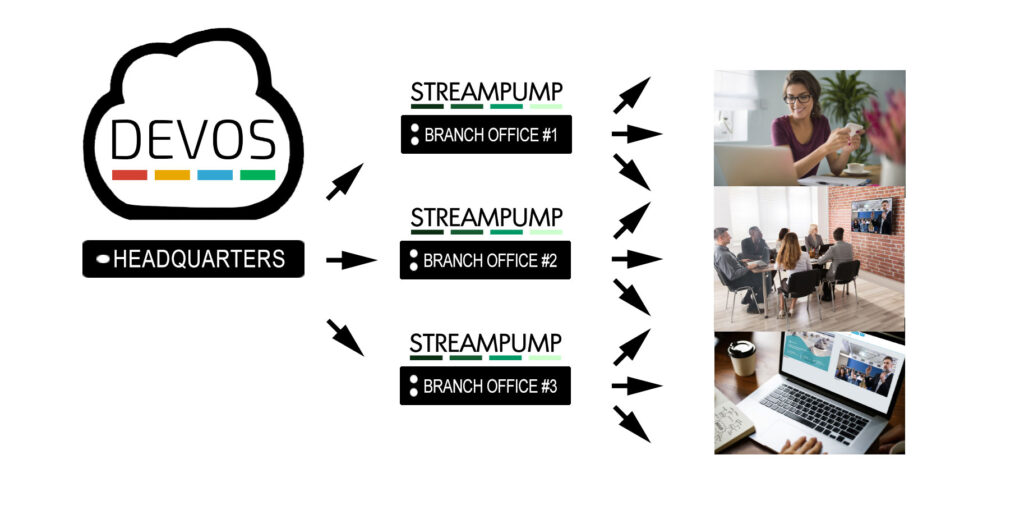eCDN = Local Streaming Control
A CDN or Content Delivery Network, is a global network that caches static content (e.g., images, CSS, and videos) for websites. CDNs help improve the load time of your websites and digital media by loading the content from the CDN closest to the user. Without it, users who are not geographically close to your primary server experience excessive buffering and connectivity issues, especially when streaming live content. However, CDNs are typically commercially owned and shared by hundreds or thousands of users, not ideal for transmitting your company’s proprietary material.
An eCDN, or enterprise Content Delivery Network, is typically used to stream and serve your private video and media content over internal networks. Your content is brought behind the firewall, allowing you to control video distribution while securing. eCDNs eliminate the need for an advanced corporate wide area network (WAN), and reach any employee or student regardless of location.
Simply put, eCDNs are best suited for internal use, and CDNs for delivering content outside of your organization.
How an eCDN works
eCDN facilitate the intelligent routing of the flow of video traffic around the network to improve performance and reduce or eliminates congestion, especially when many viewers are watching the same streaming content simultaneously, such as a live broadcast.
Even before the #workfromhome revolution, live stream viewers were connecting to your network from many different endpoints. Likewise, the content was originating from a variety of sources, like meeting rooms, the CEO’s office, and HR online training.
Without the use of an eCDN, creating a secure network to serve live content to and from many endpoints is time consuming and expensive. Additionally, a large number of connections places tremendous pressure on your internet connection, straining the network and delivering frustrating viewing experiences.
An eCDN service, like DiscoverVideo’s Enterprise Video System, deploys ‘edge servers’ throughout the corporate network to deliver your encoded live video content across your corporate network. It helps to alleviate the pressure on your ISP, router, and firewall, resulting in smooth, buffer-free live video for your viewers.

Read about types of eCDNs and when to deploy each.
More eCDN Benefits
In addition to professional-quality live video, eCDNs offer the following benefits:

- Cost savings
Less strain on your corporate network helps to reduce bandwidth consumption and prevents the need for costly network upgrades. Live and on-demand video for employee training and onboarding saves on in-person transportation and lodging. - Flexible video formats
Adaptive bitrate technology and multicasting enable video content to be transcoded in a variety of formats and viewed with any bandwidth. - Optimized network delivery
Your network delivery speed is enhanced through dynamic caching and impact on network bandwidth usage is further reduced. - Easy administration
Web-based administration is a standard feature, easily allowing technicians to monitor deployment and network status.
What to Look for in an eCDN
There are many eCDNs on the market capable of delivering high-quality live video to employees within your corporate network. Here are the main factors to consider when making a selection:
- Pricing
eCDNs vary widely in their pricing models. Some charge per user, others use an annual or monthly subscription model with a bandwidth and storage allocation. Live streaming will affect price – the frequency, number of viewers, video quality, bitrates, resolution, formats, and more. Some services offer on-premises and/or cloud-based transcoding, video platforms and players, and video analytics separately. - Scalability
Consider what you’re streaming and how flexible you need your service to be. Do you need to stream small internal training sessions? Or do you plan to stream large live events to offices across the globe? While all eCDNS can stream to a relatively small audience, not all are capable of live streaming on a larger scale. Be sure to consider your current and future live video usage. - Reliability
eCDNs are only as good as their uptime guarantee, so look for the one that comes closest to 100%. If reliability is the most important factor, consider a service using a multi-CDN approach. eCDNs with SD-CDN (Software Defined Content Delivery Network) technology mitigate outages by automatically switching your stream between different third-party CDNs based on performance. - Features and Integration
Some eCDNs are offered as part of a package which may include features such as cloud encoding, video players, and analytics. You’ll have to decide which features you need, and which solution best integrates with your existing infrastructure. - Customer and Technical Support
Every other criterion is worthless without exceptional professional customer support, especially when live video is concerned. White-glove service from a knowledgeable support team is an excellent safety net, whether that’s a worst-case scenario to get your stream back on track or answering questions about deployment and maintenance.
eCDN Summary
Live and on-demand video use continues to grow as a corporate communication channel, making effective and efficient management even more important. The eCDN you choose should check all the boxes for privacy, flexibility, scalability, reliability, value, and support. That’s why you should consider our DEVOS on-premise server for all of your in-house video streaming and media management.






